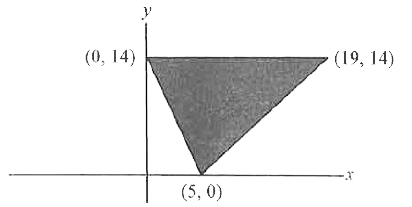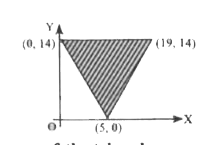Shade the region given by inequality
2x+y≥6
The correct Answer is:N/a
To solve the inequality 2x+y≥6 and shade the appropriate region, follow these steps:
Step 1: Convert the inequality to an equation
First, we convert the inequality into an equation to find the boundary line:
2x+y=6
Step 2: Find the intercepts
To graph the line, we can find the x-intercept and y-intercept.
- Finding the x-intercept: Set y=0:
2x+0=6⟹2x=6⟹x=3
So the x-intercept is (3,0).
- Finding the y-intercept: Set x=0:
2(0)+y=6⟹y=6
So the y-intercept is (0,6).
Step 3: Plot the intercepts on the graph
Now, plot the points (3,0) and (0,6) on a Cartesian plane.
Step 4: Draw the boundary line
Since the inequality is ≥, we will draw a solid line through the points (3,0) and (0,6) to indicate that points on the line are included in the solution set.
Step 5: Determine the shading direction
To find out which side of the line to shade, we can test a point not on the line. A common choice is the origin (0,0).
Substituting (0,0) into the inequality:
2(0)+0≥6⟹0≥6(False)
Since this statement is false, we shade the opposite side of the line from the origin.
Step 6: Shade the appropriate region
Shade the region above the line 2x+y=6 to represent the solution set of the inequality 2x+y≥6.
---
First, we convert the inequality into an equation to find the boundary line:
2x+y=6
To graph the line, we can find the x-intercept and y-intercept.
2x+0=6⟹2x=6⟹x=3
So the x-intercept is (3,0).
2(0)+y=6⟹y=6
So the y-intercept is (0,6).
Now, plot the points (3,0) and (0,6) on a Cartesian plane.
Since the inequality is ≥, we will draw a solid line through the points (3,0) and (0,6) to indicate that points on the line are included in the solution set.
To find out which side of the line to shade, we can test a point not on the line. A common choice is the origin (0,0).
2(0)+0≥6⟹0≥6(False)
Since this statement is false, we shade the opposite side of the line from the origin.
Shade the region above the line 2x+y=6 to represent the solution set of the inequality 2x+y≥6.
Topper's Solved these Questions
- LINEAR INEQUALITIESBOOK - NAGEEN PRAKASHAN ENGLISHCHAPTER - LINEAR INEQUALITIESEXERCISE - MISCELLANEOUS EXERCISE
14 Videos
- LINEAR INEQUALITIESBOOK - NAGEEN PRAKASHAN ENGLISHCHAPTER - LINEAR INEQUALITIESEXERCISE - EXERCISE
76 Videos
- LIMITS AND DERIVATIVESBOOK - NAGEEN PRAKASHAN ENGLISHCHAPTER - LIMITS AND DERIVATIVESEXERCISE - Miscellaneous Exercise
30 Videos
- MATHEMATICAL REASONING BOOK - NAGEEN PRAKASHAN ENGLISHCHAPTER - MATHEMATICAL REASONING EXERCISE - Misellaneous exercise
7 Videos
Similar Questions
2≤3x−4≤5 find x
View SolutionSolve the inequation 3x−2<5 If (i) x∈ N (ii) x ∈ R and represent the solution on the number line
View SolutionFind the derivative of the following functions from first principles: (i) x (ii) (−x)−1 (iii) s∈(x+1) (iv) cos(x−π8)Find derivative of the following functions (it is to be understood that a, b, c, d, p, q, r and s a
View SolutionWrite the negation of the following statements:(i) p : For every positive real number x, the number x−1is also positive.(ii) q : All cats scratch.(iii) r : For every real number x, either x>1or x<1.
View SolutionThe shaded region for the inequality x+5y≤6 is
View SolutionDetermine the region in the plane determined by the inequalities.
y≥2x,−2x+3y≤6.
View SolutionDetermine the region in the plane determined by the inequalities.
2x+y≥8,x+2y≥8,x+y≤6.
View SolutionThe shaded region shown in the figure is given by the inequations
View SolutionDetermine the region in the plane determined by the inequalities y≥2x and −2x+3y≤6.
View SolutionThe shaded region shown in fig. is given by the inequations :
View SolutionSolve the inequality graphically 2x+y≥6
View SolutionThe shaded region shown in the figure is given by the inequations

View SolutionShade the region given by the inequality x≥2
View SolutionShade the region given by the linear inequality x+2y>3
View SolutionThe shaded region shown in fig. is given by the inequation

View Solution